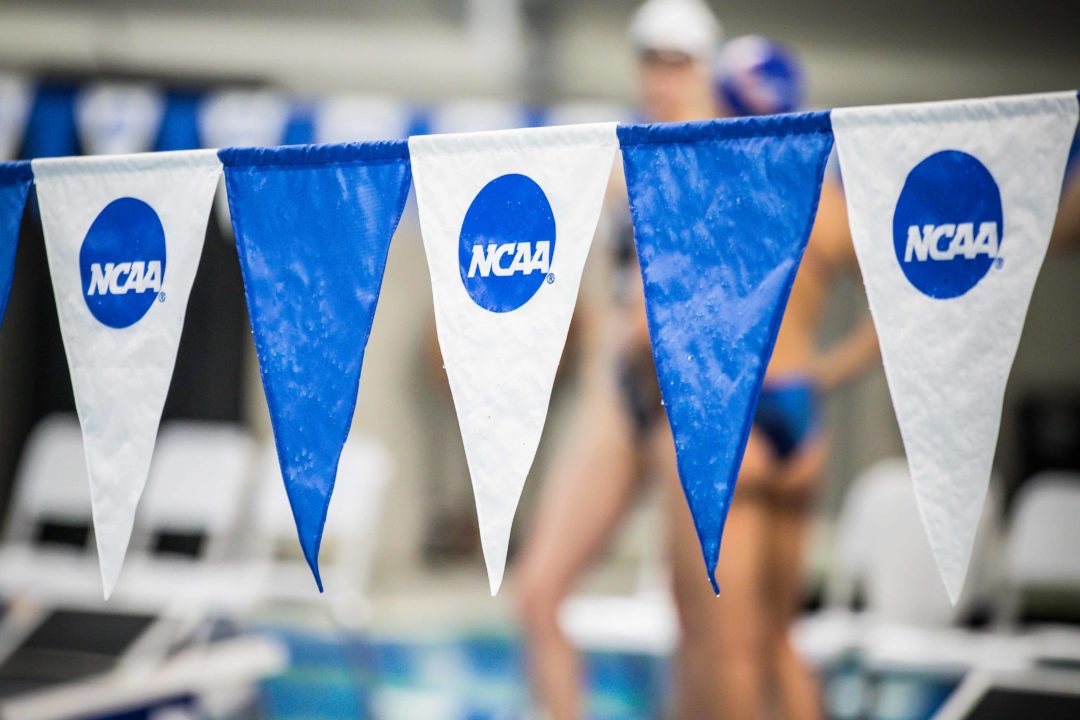The NCAA Division III cuts for the 2019-20 season have officially been released. Just as last season’s cuts, more than half of the total time standards have been made faster. Going in depth with the changes, 10 total A cuts and 22 total B cuts have been changed for the upcoming D3 season.
Last year, 36 of the 62 total cuts were changed while this year 32 of the cuts were changed. Among the time changes, the women’s 200 IM A cut has drastically dropped by a full second, going from a 2:00.48 down to 1:59.49 (-0.82%).
In the same manner, both A and B cuts for the men’s and women’s 100 back along with the men’s 200 back B cut have dipped under big time barriers.
| Event | 2018-19 | 2019-20 |
| Men’s 100 BK B Cut | 50.13 | 49.91 |
| Men’s 100 BK A Cut | 47.27 | 46.97 |
| Men’s 200 BK B Cut | 1:50.04 | 1:49.86 |
| Women’s 100 BK B Cut | 57.00 | 56.82 |
| Women’s 100 BK A Cut | 54.12 | 53.94 |
Looking into differences between the men’s and women’s standards, the women had 6 updated times while the men had 6. Both genders each had 11 updated B cuts, totaling 18 updated times a piece for each gender.
Event-wise, the men’s 100 free and 100 back A cuts have changed both this season and last season. Among the other events following the same trend are the men’s 50/100/200/500 free B cuts and women’s 100 breast B cuts. On the other hand, the men’s A/B cuts for the 1650 free and women’s A/B 500 free cuts have not been updated since 2018.
Below are the official 2019-20 standards:
- Updated 2019-20 times are in bold
| Men | Women | |||
| A Standard | B Standard | Event | A Standard | B Standard |
| 19.48 | 20.61 | 50 free | 22.72 | 23.68 |
| 43.31 | 45.27 | 100 free | 49.31 | 51.71 |
| 1:36.74 | 1:40.03 | 200 free | 1:47.13 | 1:52.15 |
| 4:20.26 | 4:33.22 | 500 free | 4:45.33 | 5:00.62 |
| 15:02.59 | 16:16.65 | 1650 free | 16:27.52 | 17:33.69 |
| 46.97 | 49.91 | 100 back | 53.94 | 56.82 |
| 1:44.47 | 1:49.86 | 200 back | 1:55.94 | 2:03.37 |
| 52.11 | 56.06 | 100 breast | 1:00.67 | 1:04.60 |
| 1:53.85 | 2:04.80 | 200 breast | 2:12.91 | 2:21.91 |
| 47.19 | 49.31 | 100 fly | 52.92 | 56.58 |
| 1:45.50 | 1:50.85 | 200 fly | 1:56.90 | 2:05.61 |
| 1:45.47 | 1:51.45 | 200 IM | 1:59.49 | 2:06.41 |
| 3:47.19 | 4:01.49 | 400 IM | 4:13.77 | 4:30.76 |
| 1:22.44 | 200 free relay | 1:35.63 | ||
| 3:03.10 | 400 free relay | 3:29.60 | ||
| 6:47.12 | 800 free relay | 7:39.30 | ||
| 1:30.97 | 200 medley relay | 1:45.28 | ||
| 3:21.21 | 400 medley relay | 3:51.41 | ||
You can also view the official time standards sheets here:
For the second year in a row, the NCAA Division III Championships will be held at the Greensboro Aquatic Center in Greensboro, North Carolina. The meet is scheduled to take place March 18-21, 2020.
The three powerhouse programs to keep on eye on for the upcoming season are the Emory Eagles, Kenyon Lords, and the Denison Big Red. The Emory women will be chasing their 12th-consecutive team title while the Denison men will aim for their 3rd-consecutive team title.

I’m always confused on what the point is of the A Cuts in Division III. Those are usually faster than the winning time for the previous year. So, why have them at all? Case in point, the winning time in the women’s 500 last year was 4:48.15 and the A cut this year is 4:45.33. They don’t seem to be relevant.
It’s because the A cuts are based on the average of the winning times for the past few years. There’s oftentimes a swimmer that posts such a fast winning time in an event that it pulls down the cut for the next couple years. A good example is Andrew Wilson’s 1:50 in the 200 breast pulling down the A cut for that event. Last year, the 200 breast was won with a 1:57, but since Wilson’s time is factored into the average, the cut still remains a 1:53.
They’re pointless in all of the divisions, as the cut lines go significantly lower than the number of A cuts in a given event, and anyone that has any chance of swimming an A cut is getting invited regardless of where those lines are.
If memory serves, this actually stemmed from an issue about 6-7 years ago where something like 13 men made the A cut in the 100 fly. I don’t remember the exact details, but the selection criteria at the time was not designed with such a large number of A cut qualifiers in mind. The unusually high number of A cut times messed up the numbers that the NCAA was expecting to bring to that meet in other events. By making the A cut the average of the winning time from the previous three years, yes it effectively puts the cut out of reach for mere mortals, but allows for more flexibility in making sure that the participation numbers are a)… Read more »
Don’t sleep on Johns Hopkins